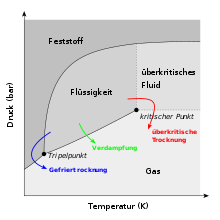Adsorption drying
In adsorption drying , adsorption dryers or drying cabinets are used, which remove moisture with appropriate drying agents. The process works according to the sorption principle .
Drying process
The biggest differences in the drying process are in the use of desiccants and the either temporary or permanent dehumidification processes. While rotational dehumidification takes place permanently, the not completely sealed construction means that dehumidification below 5% relative humidity cannot be achieved. On the other hand, with a static chamber principle, values below 0.5% relative humidity can be achieved.
Rotary dehumidification
Is a special form of the adsorption dryer. Similar to condensation drying, in this process the process air to be dehumidified is sucked into the rotary dehumidifier . The process air is then passed through a rotor coated with metal silicate , which removes moisture from the air . The dehumidified process air is then heated and returned to the room. With a hot air flow in the countercurrent of the sorption rotor, the previously absorbed moisture is absorbed again via the regeneration air and released to the outside air with the help of the rotor .
Chamber dehumidification
The chamber dehumidification works in time segments and therefore does not dehumidify continuously. First, the process air is passed through a container with a zeolite bed. The moisture is then driven out of the zeolite A with heated air of approx. 200 ° C and vented - either through a flap system, ventilation flaps or a valve . After this process, known as regeneration, the filter unit is returned to the process air flow. This process achieves relative humidity below 0.5%. The latest drying cabinets work according to this principle .
Application area
There are various areas of application for adsorption drying, whereby the drying to be achieved is decisive for the selection of the drying method. In the area of building drying, a relative humidity of 20% is sufficient, otherwise the building will overdry and thus lead to stress cracks . In electrical engineering, on the other hand, dehumidification is only interesting from below 1% relative humidity in order to remove hygroscopic deposits from sensitive components without heat and thus thermostress and to stop further oxidation. The same applies to use in the laboratory environment. This can only be achieved with a drying cabinet .
Building drying
An adsorption dryer is suitable for dehumidifying a room, the volume of which is twice as large as the amount of dry air generated by the dryer.
Temperature: approx. −10 ° to +30 ° C. Humidity
: 0% to 100% relative humidity
Adsorption dryers are preferred for applications with low humidity. These can reach a target humidity of almost 5%. Adsorption dryers are primarily used when: 1. A very low relative humidity of less than 35% is to be achieved (for example pharmaceutical and chemical industry, ammunition stores, etc.) 2. Work is only carried out at extremely low temperatures (for example cold rooms) 3. Low dew temperatures are necessary or climatic (e.g. ship renovation)
advantages
- Can also be used at temperatures below 0 ° C degrees Celsius
- Larger performance range than condensation dryer
- Air drying up to a humidity value of almost 5%
- Can be used for almost all water or moisture damage that occurs in practice
- Since the moisture is released via an air stream, no water container needs to be emptied (operation without regular checks)
disadvantage
- Risk of overdrying and the resulting damage (e.g. cracks in wooden stairs).
- High energy consumption due to the large amount of waste heat
- The humid regeneration air from the counterflow of the sorption rotor must be discharged to the outside air via an opening in the building
- The water vapor must be discharged through a window or wall opening. This means that adequate supply air must be provided in the room.
- The integrated heating element requires a run-on phase, which means that there is a risk of overheating with appliances from the household series. This problem is significantly reduced with professional devices.
Web links
- How adsorption drying works using a rotary adsorber
- Dipl.-Ing. Frank Schimmelmann, Division Manager Process Air Drying at ULT AG, Löbau: Technical article on process air drying in the chemical industry
